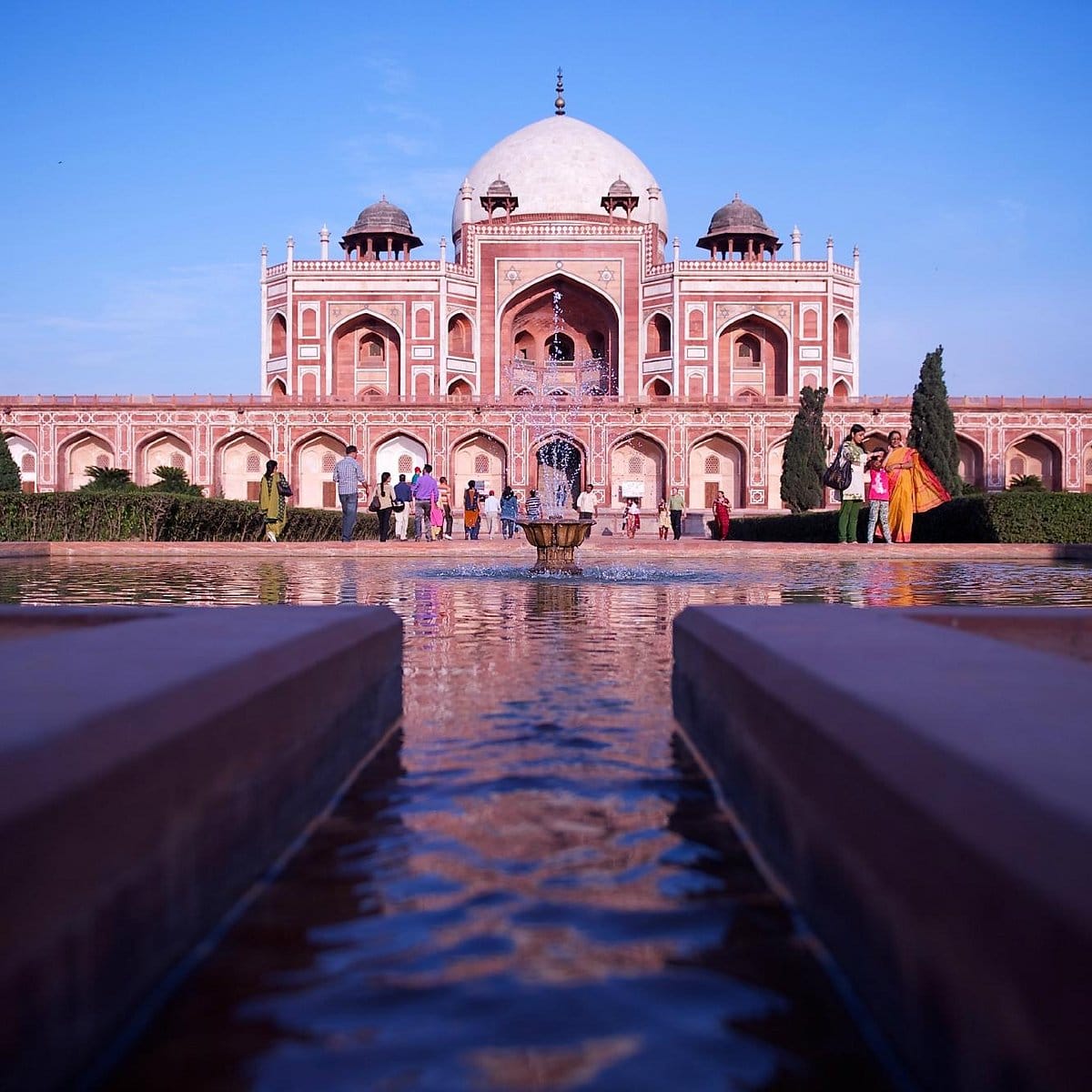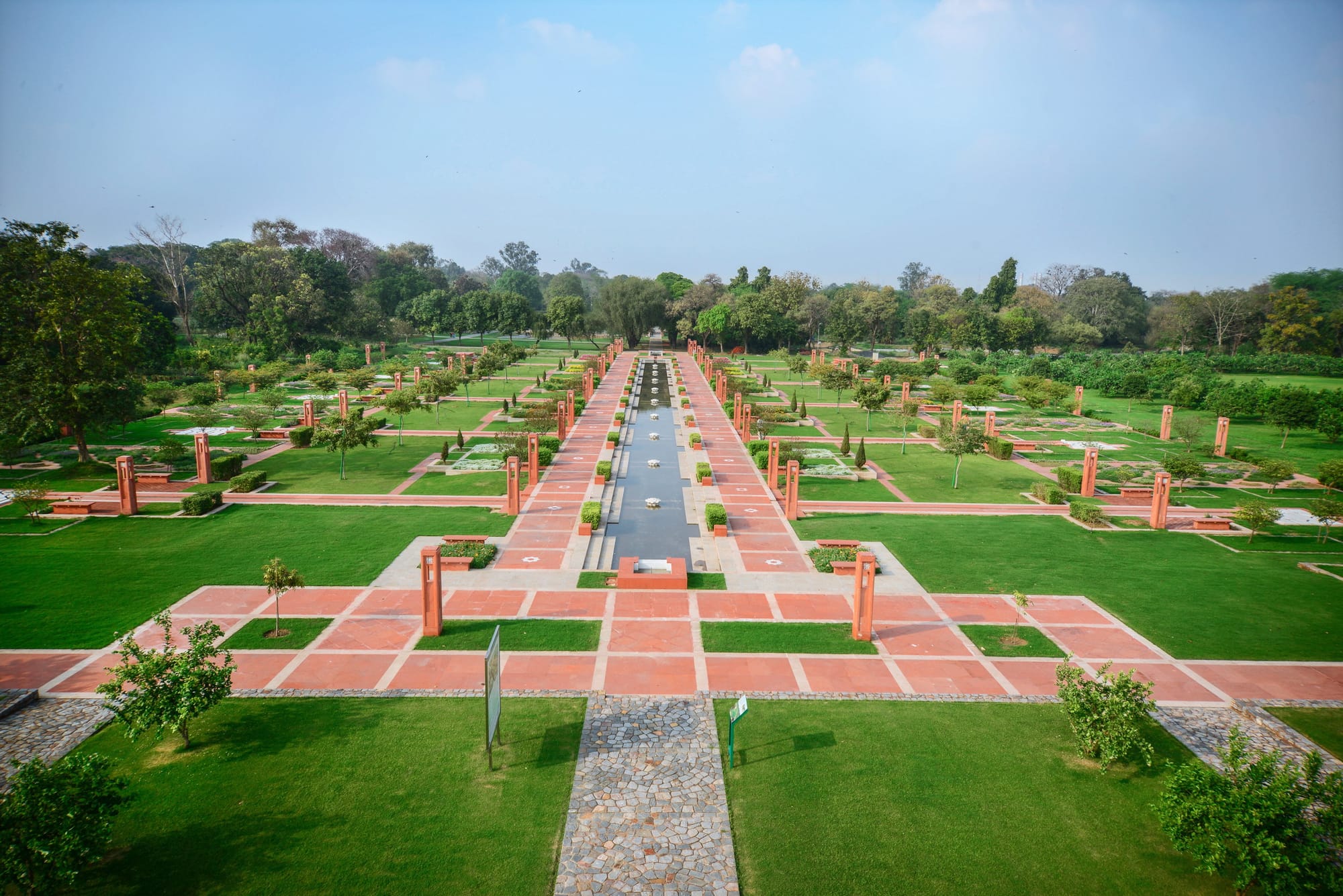Humayun's Tomb
Humayun's Tomb is a masterpiece of Mughal architecture and a UNESCO World Heritage Site. Commissioned by Empress Bega Begum for her husband, it is a testament to Mughal artistic excellence and remains a symbol of enduring love and cultural heritage.

Humayun's Tomb, located in the heart of Central South Delhi, is a masterpiece of Mughal architecture and a UNESCO World Heritage Site. Built in the mid-16th century, it's a remarkable example of Persian and Indian architectural fusion, serving as a precursor to the Taj Mahal. The tomb's symmetrical design, with its grand dome and intricate marble lattice work, exudes elegance and grandeur. Surrounded by lush gardens and water channels, it creates a serene ambiance. Commissioned by Empress Bega Begum for her husband, Emperor Humayun, it stands as a testament to Mughal artistic excellence and remains a symbol of enduring love and cultural heritage.
History
Humayun's Tomb was built to serve as the final resting place for Emperor Humayun, the second ruler of the Mughal Empire. Emperor Humayun ruled from 1530 to 1556 and was known for his patronage of the arts and architecture. His untimely death in 1556 left a power vacuum, which was eventually filled by his son, Akbar the Great.
The construction of Humayun's Tomb was commissioned by Humayun's widow, Empress Bega Begum, shortly after his death. Bega Begum was deeply devoted to her husband and was determined to honor his memory in a fitting manner. She spared no expense in building a mausoleum that would reflect Humayun's stature as an emperor and showcase the cultural sophistication of the Mughal Empire.
Beyond serving as a burial place for Emperor Humayun, the tomb also had symbolic significance. It was meant to demonstrate the continuity and stability of the Mughal dynasty, despite the challenges it faced during Humayun's reign. Additionally, the construction of grand mausoleums was a common practice among Mughal rulers, serving both as a statement of power and as a means of securing their legacy for future generations.
Humayun's Tomb was not only a testament to the love and devotion between Emperor Humayun and Empress Bega Begum but also a reflection of the Mughal Empire's commitment to artistic excellence and cultural patronage.
The architectural style of Humayun's Tomb reflects the cultural synthesis that characterized the Mughal Empire. The Mughals were renowned for their ability to integrate elements from various cultures into their architecture, resulting in structures that were not only aesthetically pleasing but also culturally significant.
One of the most striking features of Humayun's Tomb is its symmetrical design, which is a hallmark of Mughal architecture. The tomb is set in the center of a vast square garden, divided into four quadrants by water channels and pathways. This layout reflects the influence of Persian gardens, which were known for their geometric precision and emphasis on symmetry.

The main structure of the tomb is crowned by a massive dome, which rises to a height of over 40 meters. The dome is flanked by smaller domed chhatris (pavilions) at each corner, creating a visually striking profile against the Delhi skyline. The use of red sandstone and white marble gives the tomb a regal appearance, while intricate carvings and inlay work add to its beauty.
The facade of Humayun's Tomb is adorned with delicate geometric patterns, arabesques, and calligraphy, showcasing the skill of Mughal artisans. The intricate details carved into the marble panels tell stories from Islamic tradition and pay homage to the achievements of Emperor Humayun.
The interior of the tomb is equally impressive, with a spacious central chamber surrounded by smaller chambers and corridors. The central chamber houses the cenotaph of Emperor Humayun, while the actual grave lies in a crypt below. The use of marble and sandstone continues inside, creating a sense of harmony and continuity with the exterior.

Humayun's Tomb holds great historical significance as the final resting place of Emperor Humayun, the second ruler of the Mughal Empire. Humayun ruled from 1530 to 1556 and was known for his patronage of the arts and architecture. His untimely death in 1556 left a power vacuum, which was eventually filled by his son, Akbar the Great.
The construction of Humayun's Tomb was commissioned by Humayun's widow, Empress Bega Begum, shortly after his death. Bega Begum was a devoted wife and a passionate patron of the arts, and she spared no expense in honoring her husband's memory. The tomb took eight years to complete and was finished in 1572.
After its completion, Humayun's Tomb became the inspiration for many others, including the zenith of Mughal mausoleums, the Taj Mahal. Its innovative architectural style and use of materials set a new standard for funerary architecture in India and influenced generations of builders.
Over the centuries, Humayun's Tomb has undergone periods of neglect and restoration. The monument lost a significant bit of its shine as the Mughals declined in power. Its nadir came after the last Mughal emperor, Bahadur Shah Zafar was captured by the British as he sought refuge in the tomb during the Revolt of 1857. Consequently, the Charbagh was replaced with an English style garden after the Brits established complete control over Delhi.
However, at the turn of the century, extensive efforts were made to preserve and restore the tomb to its former glory. Lord Curzon ordered a reversal to the Charbagh-style gardens and a major restoration project that took place until 1909. In 1993, it was designated a UNESCO World Heritage Site, recognizing its cultural and historical significance, which led to new efforts being made towards its restoration.
It continues to attract visitors worldwide, who marvel at its beauty and learn about its rich history. As a symbol of love, devotion, and artistic excellence, it remains one of India's most treasured landmarks.
Other Monuments and Attractions Nearby
Isa Khan’s Mosque and Tomb
The tomb is dedicated to Isa Khan Niazi, a nobleman in the court of Sher Shah Suri, who ruled Delhi in the mid-16th century. The structure, built in 1547-48, predates Humayun's Tomb and exhibits a far simpler architectural style. It is constructed mainly of sandstone and features a square chamber topped with a dome, surrounded by a verandah with intricate jali (lattice) work. Adjacent to the tomb is the Isa Khan Mosque, also built during the same period. This mosque follows a traditional Indian architectural style with elements such as chhatris (pavilions) and jaalis. It serves as a place of worship and reflects the religious and cultural syncretism prevalent during the Mughal era.

Arab Serai
The Arab Serai, also known as Arab Sarai, is a historical site located in the vicinity of Humayun's Tomb in Delhi, India. Built during the Mughal era, likely in the 17th century, the Arab Serai served as a lodging and trading area for merchants and travelers from the Arab world. The term "Serai" refers to a type of caravan serai, which was a roadside inn or resting place for travelers, especially merchants and their caravans. These structures were essential for facilitating trade and travel along the ancient trade routes. The Arab Serai was specifically designated to accommodate Arab traders who traveled to Delhi for commerce and diplomatic purposes.
Nai ka Gumbad
Nai Ka Gumbad is a domed mausoleum believed to have been constructed to honor a royal barber or someone associated with the Lodi rulers. It stands out for its distinct architectural features, including a large dome atop a square base, adorned with intricate carvings and decorative elements.The tomb is constructed primarily of local grey quartzite stone, typical of the architectural style prevalent during the Lodi period. Its simplicity and elegance reflect the architectural preferences of the time, characterized by minimal ornamentation and a focus on geometric shapes and proportions. Despite its name, which translates to "Barber's Dome," the exact identity of the person buried within the tomb remains unknown.

Nila Gumbad
The Nila Gumbad, meaning "Blue Dome," is believed to be the tomb of a nobleman or a prominent figure from the Lodi dynasty, but just like Nai ka Gumbad, the identity of the person buried within remains uncertain. The monument derives its name from the striking blue tiles that once adorned its dome, giving it a distinctive appearance against the skyline. The structure is predominantly constructed of red sandstone, with marble embellishments adding to its grandeur. Despite its relatively modest size compared to other Mughal tombs, such as Humayun's Tomb or the Taj Mahal, the Nila Gumbad exudes an air of elegance and refinement.

Chillah Nizamuddin Aulia
The Chillah of Hazrat Nizamuddin Aulia, also known as the Khanqah or Sufi retreat, holds immense significance for Sufi Muslims and devotees of Hazrat Nizamuddin Aulia, one of the most prominent Sufi saints in the Indian subcontinent. He was a prominent disciple of Hazrat Baba Fariduddin Ganjshakar, and his teachings emphasized love, devotion, and the pursuit of inner spirituality.The Chillah is a place where Hazrat Nizamuddin Aulia spent a considerable amount of time in meditation, contemplation, and spiritual reflection. It serves as a symbol of his spiritual journey and his commitment to the path of Sufism. The structure of the Chillah is simple yet profound, reflecting the ascetic lifestyle embraced by Hazrat Nizamuddin Aulia. It typically consists of a small room or cell where the saint would retreat for extended periods, seeking solitude and communion with the divine.
Throughout history, the Chillah of Hazrat Nizamuddin Aulia has attracted pilgrims, seekers, and devotees from all walks of life, drawn by the saint's reputation for wisdom, compassion, and miracles. It continues to be a place of spiritual pilgrimage and contemplation, where visitors come to pay their respects, seek blessings, and experience the tranquility of Sufi spirituality. The atmosphere surrounding the Chillah is imbued with a sense of serenity and devotion, with devotees often engaging in prayers, recitations of poetry, and Sufi music known as qawwali. The teachings of Hazrat Nizamuddin Aulia, centered on love, tolerance, and service to humanity, continue to resonate deeply with people of diverse backgrounds and beliefs.
Nizamuddin Dargah
The dargah, or shrine, is a place of pilgrimage and spiritual significance for millions of devotees, regardless of their religious affiliations. The architecture of the dargah comprises several structures, including the tomb of Hazrat Nizamuddin Aulia, adorned with intricate marble lattice work, calligraphy, and colorful embellishments.

One of the defining features of the Nizamuddin Dargah is its vibrant atmosphere, characterized by the sounds of qawwali music, devotional poetry, and the fragrance of incense. Devotees gather at the dargah to offer prayers, seek blessings, and participate in spiritual gatherings known as mehfils. The dargah is also known for its role as a center of social welfare and community service. It hosts charitable initiatives, free meals for the needy (langar), and other philanthropic activities, in line with the teachings of Hazrat Nizamuddin Aulia, who emphasized the importance of compassion and service to humanity. The annual Urs festival, commemorating the death anniversary of Hazrat Nizamuddin Aulia, is a major event at the dargah, marked by fervent devotion, music, and celebrations. The Nizamuddin Dargah serves as a spiritual oasis in the bustling metropolis of Delhi, offering solace, inspiration, and a sense of belonging to all who seek it.
Sundar Nursery
Sunder Nursery is a historic garden complex transformed into a haven. Originally established during the Mughal era, it underwent extensive restoration, blending historical preservation with modern landscaping techniques. The nursery boasts diverse flora, including rare indigenous species, spread across its picturesque landscape. Its pathways meander through lush greenery, dotted with ancient monuments, pavilions, and water features, creating a serene ambiance for visitors. Sunder Nursery serves as not only a botanical oasis but also a cultural and recreational destination, inviting exploration and contemplation amidst its natural and historical splendor.

Food Near Humayun’s Tomb
Near Humayun's Tomb you'll find a variety of food options to suit different tastes and preferences. Along Nizamuddin East and nearby areas, you can explore numerous eateries, cafes, and street food stalls offering delicious Indian cuisine.
- Nizamuddin area: You can try local street food vendors offering snacks like chaat (spicy and tangy snacks), kebabs from old eateries like Ghalib Kebab Corner, and sweets like shahi tukda, jalebi and rabri.
- Khan Market: Located a short distance away, Khan Market hosts a plethora of restaurants, cafes, and bakeries serving both Indian and international cuisines. Some names that come to mind are L’Opera, The Big Chill Cafe, Perch Coffee and Wine Bar and The Blue Door Cafe.
- Lodhi Colony: This trendy neighborhood features hip cafes, bistros, and restaurants offering a range of cuisines from around the world, including Italian, Mediterranean, and fusion cuisine.
Whether you're craving traditional Indian dishes, international cuisine, or simply want to indulge in some street food delights, you'll find plenty of options to satisfy your hunger near Humayun's Tomb.
Timings and Ticket Prices
As of my last update in January 2022, here are the general ticket prices and timings for visiting Humayun's Tomb in Delhi, India. However, please note that these details may have changed since then, so I recommend checking the official website or contacting the authorities for the most up-to-date information:
Ticket Prices:
1. Indian Citizens (including SAARC and BIMSTEC nationals): INR 40 per person
2. Foreign Tourists: INR 600 per person
Children below 15 years of age can get free entry.
Humayun's Tomb is generally open to visitors every day of the week, except on Fridays.
Opening Hours:
Summer Timings (April to September): 6:00 AM to 6:00 PM
Winter Timings (October to March): 7:00 AM to 5:00 PM
Transport
Humayun's Tomb in Delhi, India, is easily accessible by various modes of transportation. Here are some common options:
- Metro: The nearest metro station to Humayun's Tomb is the Jawaharlal Nehru Stadium Metro Station on the Violet Line. From there, you can take an auto-rickshaw or a taxi to reach the tomb. Alternatively, you can also take an e-rickshaw from the Hazrat Nizamuddin Metro Station on the Pink Line.
- Bus: Delhi Transport Corporation (DTC) operates several bus routes that pass near Humayun's Tomb. You can check the DTC website or use a transportation app to find the most convenient bus route.
- Taxi/Auto-rickshaw: Taxis and auto-rickshaws are readily available throughout Delhi. You can hire one from your location directly to Humayun's Tomb. You can use a ride-hailing app like Ola or Uber for convenience.
Before planning your visit, it's advisable to check the current transportation options and routes, as well as any updates or changes due to traffic conditions or events in the area. Additionally, consider factors such as traffic congestion and parking availability, especially during peak hours and weekends.




